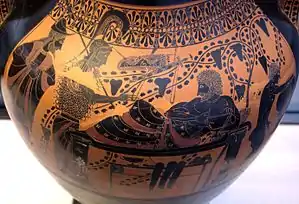Lysippides Painter
The Lysippides Painter was an Attic vase painter in the black-figure style. He was active around 530 to 510 BC. His real name is not known.

Life and work
His conventional name is derived from a kalos inscription on a neck amphora in the British Museum (B 211). He is considered the most significant pupil of Exekias, from whom he adopted not only his artistic style but also some important motifs, such as Ajax and Achilleus playing a board game. He also frequently painted scenes involving the hero Herakles. In total, about 30 known vases are ascribed to him.
His collaboration with the Andokides Painter, usually considered the inventor of red-figure vase painting is unusual. On seven bilingual vases, six belly amphorae and a cup (now in Palermo), he painted the red-figure side, while the Andokides Painter was responsible for the black-figure one. At times, the subjects painted by both are identical. It remains disputed amongst scholars whether both painters are identical and merely represent one artist using both techniques. Already John Beazley saw them as separate artists, an argument later developed by Beth Cohen and Heide Mommsen. The identity of the two painters is supported by Konrad Schauenburg, Herbert Marwitz and John Boardman. Martin Robinson and others remained undecided.
Style
The Lysippides Painter's works consisted of many neck-amphorae that were based on the works of Exekias, his mentor. Lysippides' works however, were simplified compared to those of Exekias. This style actually became very popular in the Archaic Period. Especially showing in the late 6th century and early 5th as his neck-amphorae stand on the front lines of a series of vases.[1] Many of his works were extremely similar to Exekias. A vase in Detroit depicts the mythical Greek hero, Herakles wrestling a lion. This depiction takes after a neck-amphorae version done by Exekias in multiple ways. While there is no saying that Lysippides is the painter, the vase is grouped with his work stylistically in the way it takes after Exekias and that the work narrows all the attention on Herakles' role in the battle rather than the lion's. These elements are strongly associated with the work of the Lysippides Painter.[2] Like most artists during this time, his work contained many religious references of Greek gods and goddesses in his work. Herakles being one of the more popular.


Works
bilingual belly amphorae, painted in collaboration with the Andokides Painter
- Bologna, Museo Civico Archeologico
- bilingual belly amphora 151
- bilingual belly amphora 99.538
- bilingual belly amphora 01.8037
Front and back: Achilles and Ajax playing a board game[6][7]
- bilingual belly amphora B 193
other works (selection)
- belly amphora 62b
- eye-cup GR 12.1937
- Front: Dionysos with Kantharos between two satyrs, back: Herakles and Kyknos, interior: gorgoneion[13]
- London, British Museum
- neck amphora B 211
- eye-cup B 426
- oinochoe B 492
- belly amphora II 1 B 70
- Munich, Staatliche Antikensammlungen
- neck amphora 1478
- neck amphora 1575
- eye-cup 2080
- neck amphora 208
- belly mphora 1965.100 (formerly Northwick, Spencer-Churchill collection)
- Palermo, Museo Archeologico Regionale
- Paris, Louvre
- hydria F 294
- Pregny, Baron E. de Rothschild
- belly amphora
- belly amphora 24998
- Zurich, University
- neck amphora ETH 7
Bibliography
- John Beazley: Attic Black-figure Vase-painters. Oxford 1956, p. 253-257 (p. 257-265: Style of the Lysippides Painter).
- Herbert Marwitz: Zur Einheit des Andokidesmalers, in: Jahreshefte des Österreichischen Archäologischen Institutes 46, 1961–63, p. 73-104.
- Elfriede R. Knauer: Die Berliner Andokides-Vase, Werkmonographien zur Bildenden Kunst in Reclams Universal-Bibliothek 103, Stuttgart 1965
- John Beazley: Paralipomena. Additions to Attic black-figure vase-painters and to Attic red-figure vase-painters, Oxford 1971, p. 113-116.
- John Boardman: Schwarzfigurige Vasen aus Athen. Ein Handbuch, von Zabern, Mainz 1977 (Kulturgeschichte der Antiken Welt, Vol 1) ISBN 3-8053-0233-9, p.
- Beth Cohen: Attic Bilingual Vases and their Painters, New York 1978 ISBN 0-8240-3220-9
- Martin Robertson: The art of vase-painting in classical Athens, Cambridge 1992, p. 9-14.
- Heide Mommsen: Lysippides-Maler, in: Der Neue Pauly Vol. 7, 1999, Col. 610.
- Marianne Pécasse: Recherches sur l'atelier d'Andokidès: transmission de modèles et circulation d'artisans, Dissertation Université Panthéon-Sorbonne Paris 2001
- Beth Cohen: Bilingual Vases and Vase-Painters, in: ibid.: The Colours of Clay. Special Techniques in Athenian Vases, Los Angeles 2006, p. 18-25.
- John Beazley, The Development of Attic Black-figure, Volume 24. California: University of California Press, 1951
- Madigan and Brian Christopher, Corinthian and Attic Vases in the Detroit Institute of Arts: Geometric, Black-figure, and Red-figure. Monumenta Graeca Et Romana: Print/Save 100 pages, 2008
Notes
- Beazley, John (1951). The Development of Attic Black-figure, Volume 24. California: University of California Press. p. 71.
- Madigan, Brian Christopher (2008). Corinthian and Attic Vases in The Detroit Institute of Arts: Geometric, Black-figure, and Red-figure. Monumenta Graeca Et Romana: Print/Save 100 pages. p. 17.
- http://www.beazley.ox.ac.uk/Test/Vases/ASP/ViewDetails.asp?Vnum=200010
- "Boston 99.538 (Vase)".
- "Archived copy". Archived from the original on 2007-02-23. Retrieved 2010-09-26.CS1 maint: archived copy as title (link)
- "Boston 01.8037 (Vase)".
- "Archived copy". Archived from the original on 2007-10-25. Retrieved 2010-09-26.CS1 maint: archived copy as title (link)
- "London B 193 (Vase)".
- http://www.beazley.ox.ac.uk/Test/Vases/ASP/ViewDetails.asp?Vnum=200008
- "Munich 2301 (Vase)".
- "Louvre F 203 (Vase)".
- "Site officiel du musée du Louvre".
- http://www.beazley.ox.ac.uk/Test/Vases/ASP/ViewDetails.asp?Vnum=302232
- "Attic Black-Figure Psykter (Getty Museum)".
- http://www.beazley.ox.ac.uk/Test/Vases/ASP/ViewDetails.asp?Vnum=200014
- "Site officiel du musée du Louvre".
External links
 Media related to Lysippides Painter at Wikimedia Commons
Media related to Lysippides Painter at Wikimedia Commons- Getty-Museum